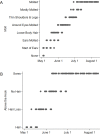Sores of boreal moose reveal a previously unknown genetic lineage of parasitic nematode within the genus Onchocerca
- PMID: 36630399
- PMCID: PMC9833588
- DOI: 10.1371/journal.pone.0278886
Sores of boreal moose reveal a previously unknown genetic lineage of parasitic nematode within the genus Onchocerca
Abstract
Long-standing reports of open sores on the hind legs of moose (Alces alces) have been recorded in Alaska (as well as Canada, Europe, and Michigan), eliciting concerns about causes and infection. We used histological and genomic methods to investigate the sores from 20 adult moose on the Kenai Peninsula, Alaska. We paired this with thermal imagery and molt scoring of adult moose to further describe sore formation and understand its timing. Severe, ulcerative and eosinophilic dermatitis was found in all moose with sores present, and microfilariae within intraepidermal pustules were additionally found in four samples. Genetic analysis of sores from moose revealed a previously unknown genetic lineage of Onchocerca. Adult moose molt and lose their barrier of protection against flies in June and July during peak fly activity, leaving them vulnerable and allowing the development of sores. In summary, our results indicate that the cause for the sores on the hindleg of moose is a previously unknown genetic lineage of Onchocerca, probably transmitted by black flies, in timing with the molt cycle of adult moose. These sores leave moose exposed to pathogens, making them vulnerable, and challenging their health and fitness.
Copyright: © 2023 Benedict et al. This is an open access article distributed under the terms of the Creative Commons Attribution License, which permits unrestricted use, distribution, and reproduction in any medium, provided the original author and source are credited.
Conflict of interest statement
The authors have declared that no competing interests exist.
Figures






References
-
- Benedict BM, Barboza PS. Adverse effects of Diptera flies on northern ungulates: Rangifer, Alces, and Bison. Mamm Rev. 2022. doi: 10.1111/mam.12287 - DOI
-
- Mauldin EA, Peters-Kennedy J. Integumentary System. In: Maxie GM, editor. Jubb, Kennedy & Palmer’s Pathology of Domestic Animals: Volume 1. St. Louis, Missouri: Saunder Ltd.; 2015. pp. 509–736.e1.
-
- Verocai GG, Lejeune M, Beckmen KB, Kashivakura CK, Veitch AM, Popko RA, et al. Defining parasite biodiversity at high latitudes of North America: new host and geographic records for Onchocerca cervipedis (Nematoda: Onchocercidae) in moose and caribou. Parasites Vectors. 2012; 5(1): 1–8. - PMC - PubMed
-
- DeNio RM, West RM. The foot-worm disease in deer of the northern Rocky Mountain region. J Forest. 1942; 40(7): 540–3.
Publication types
MeSH terms
LinkOut - more resources
Full Text Sources

